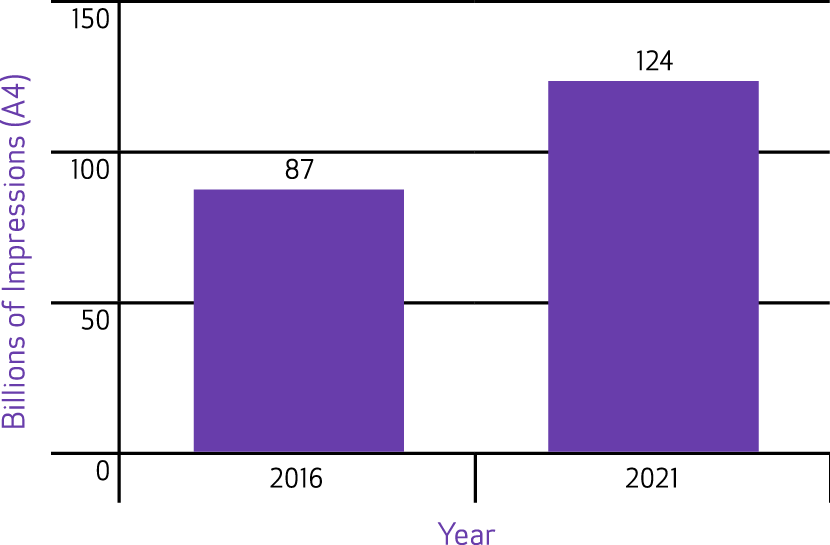Learn Why Innovation Should Be Your Priority in 2018
BOOK MANUFACTURING: 2018 BELONGS TO THOSE WHO INNOVATE AND EXECUTE!
Introduction
Although there was a time when everyone predicted that the adoption of e-readers and mobile devices would lead to the death of the printed book, the book manufacturing segment is no longer one of doom and gloom. When looking at 2018, the demand for printed books is actually increasing. With customer demands driving shorter runs and ultra-fast turnarounds, book manufacturers are rising to the challenge by meeting those demands through investments in production inkjet and digital imaging technologies.
Many of today’s new and emerging business models incorporate expanded digital print technologies and electronic distribution with intelligent workflow. Technological investments will transform the way your customers consume information in 2018, and service providers need to be at the forefront of innovation and execution in book manufacturing.
Three Essential Components of Innovation
The year 2018 will require you to think about innovative ways to blend print with your customers’ drive toward digitization. There are three essential ingredients that will drive success with book manufacturing:
Figure 1: Application Overview?—?Book Publishing

Source: U.S. Digital Production Printing Application Forecast: 2016–2021; InfoTrends 2017
1. Investing in the Right Technology
Technological investments must be made wisely and in the context of your organization’s overall business strategy. Keypoint Intelligence InfoTrends’ most recent Application Forecast?—?indicates that overall digital book printing volumes will increase from 87 billion in 2016 to 124 billion in 2021. This represents a compound annual growth rate (CAGR) of 7.3 percent.
Digital book manufacturing will continue to represent a substantial business opportunity. With a high volume of waste and other factors pushing up costs, publishers are continually seeking techniques to become more efficient by changing outdated business practices, while simultaneously producing more titles by more authors. To that end, many publishers are incorporating digital book printing into their procurement strategies — others have entirely transitioned to digital.
2. Products and Services That Are Aligned to Customers’ Communication Preferences
Regardless of size or industry, all companies face the continual challenge of defining and developing products and services that customers want to buy. According to Anthony Ulwick, a pioneer of the Jobs-to-be-Done theory and inventor of Outcome-Driven Innovation® (ODI), ?Only after knowing what jobs customers are trying to get done and what outcomes they are trying to achieve are companies able to systematically and predictably identify opportunities and create products and services that deliver significant new value. Only then can they figure out ‘what customers want.” Successful service providers are building out innovative portfolios that meet current and future consumer expectations. In the case of book publishing, service providers must understand consumer perspectives while also meeting the needs of publishers.
Although e-books are still going strong, many readers are experiencing “digital fatigue.” Individuals are spending ever-increasing amounts of time in front of screens, so many consumers find it refreshing to switch things up with tried-and-true paperbacks when reading.
And while the majority of adult fiction sales were still in the form of e-books in 2016, the trends seem to point to a decline?—?at least in the short term. The Codex Group’s survey of 4,992 book buyers found that e-book units as a share of total books purchased fell from 35.9 percent in April 2015 to 32.4 percent in April 2016. This survey includes e-books published by traditional publishers and self-publishers sold across all channels in all categories.
Today’s publishers are increasingly turning to digital production. They want to be able to print only what is needed, when it is needed. If the digital-print provider needs to have a service mindset to create incremental value for publishers, book manufacturers need a mindset to innovate, reduce costs, and improve quality to continually raise their value proposition and drive value for themselves and those with which they collaborate. The following offerings have become part of the overall business model:
Service providers need to be at the forefront of innovation and execution in book manufacturing.
- Prepublication and review copies
- Sample and complimentary copies
- Trial editions
- Variable-data printing
- Keep-in-print programs
- Course packs
- Kitting
- Single and multiple book fulfillment
- Pre- and post-production services such as file conversion, file management and storage, component-cover printing, binding, and finishing
3. It’s Time to Execute!
Coming up with ideas, or “ideating,” about new business models and opportunities is energizing as well as glamorous for many owners and executives. Ideation is the front end (or the beginning) of innovation, while implementation and execution are what convert innovative ideas into reality. Following through on plans is the behind-the-scenes dirty work. Even within the largest and most powerful businesses, big ideas won’t go anywhere if organizations don’t put the people, processes, and mechanisms in place to implement plans.
Three Essential Components of Innovation
1
INVESTING IN THE RIGHT TECHNOLOGY
2
PRODUCTS AND SERVICES THAT ALIGN TO CUSTOMERS’ COMMUNICATION PREFERENCES
3
IT’S TIME TO EXECUTE!
Chris Trimble and Vijay Govindarajan are innovation consultants and Distinguished Professors from the Tuck School of Business at Dartmouth College. Their bestselling business book entitled The Other Side of Innovation?—?Solving the Execution Challenge highlights five key steps in solving the innovation challenge:
Step 1: Acknowledge that the idea is just the beginning of the innovation process. True innovation requires discipline and the implementation of the right resources (technical, operations, and sales) for the hardest part—execution.
Step 2: Commit! Owners must be committed to driving innovation, and they need to accept the fact that ongoing traditional book manufacturing operations will not last forever.
Step 3: Redesign your organization for innovation. Book manufacturers are structured to support ongoing operations and are under pressure to deliver revenue and profits. Create an innovation team to focus on new market opportunities.
Step 4: The innovation team cannot be isolated, so a team leader must be appointed. The team leader needs to partner with ongoing operations and establish a relationship of mutual respect.
Step 5: The team needs to run a disciplined experiment to truly test the market opportunity. Business innovators must certainly leverage gut checks and emotion, but in the end, that art must be subjected to the discipline of the experiment.
2018 Belongs to Those Who Innovate and Execute!
Print service providers will need to reinvent themselves in 2018. They must come up with new ideas to keep operations, products, and services fresh and consistent with changing customer communications demands. Innovation isn’t just for large companies with enormous development budgets?—?small book manufacturers can leverage their nimbleness to quickly drive new opportunities. Coming up with new ideas is important, but it’s only one step in the overall process. Today’s businesses have a much greater task in turning that idea into an actual product or service that will benefit customers during the execution stage. The winners of 2018 will be those who innovate and execute!
